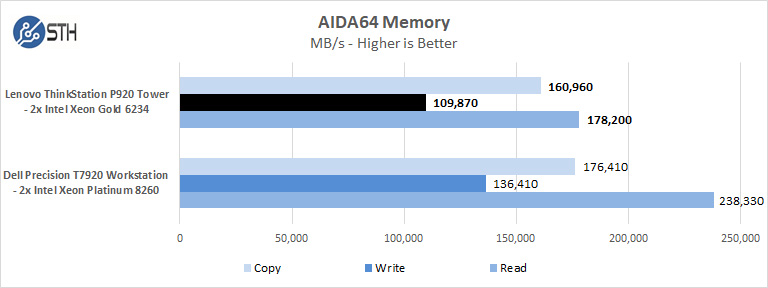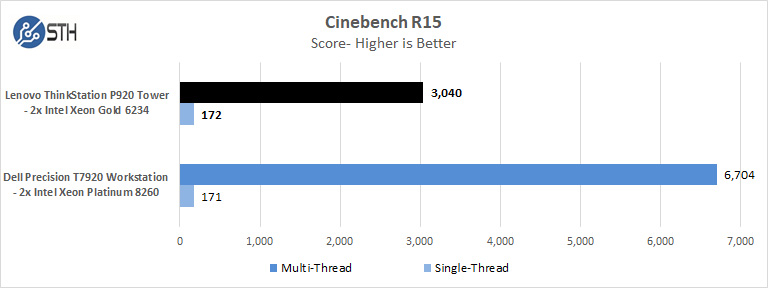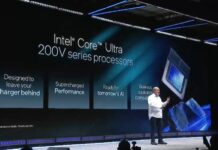Lenovo ThinkStation P920 Tower Specifications
Here is a list of how our ThinkStation P920 Tower is equipped:
- Processor: Dual Intel Gold 6234 (8 core / 16 Threads) 3.3GHz, 4.0 GHz Turbo
- Memory: 192GB DDR4 2933MHz ECC
- Graphics Card: Nvidia Quadro RTX 8000, 48GB, 4x DP, VirtualLink
- Network: Intel I219-LM Dual Gigabit Ethernet
- OS Boot: 1x M.2 Samsung PM981 1TB NVMe Solid State Drive
- Operating System Windows 10 Pro for Workstations (4 Cores Plus)
The CPU we will be using is dual Intel Xeon Gold 6234 3.3GHz (8 core/16 thread). These two processors give the system a full 16 cores/32 threads.

The Intel Xeon Gold 6234 is a very capable CPU, the base speed is 3.3GHz but can Turbo up to 4.0GHz. These are not designed to be the highest core count CPUs. Instead, they are designed to offer high memory bandwidth per core and enough TDP headroom to hold turbo clocks. If you are not bound by memory bandwidth or per-core license costs, then there are other options out there.
We also ran the NVIDIA Quadro RTX 8000 in a separate review so that we could look at the RTX 8000 and compare it to the large number of GPUs we have reviewed to date. Then in another review, we ran 2x NVIDIA Quadro RTX 8000‘s in NVLINK to examine the setup used in this review.
Let us continue with performance testing.
Lenovo ThinkStation P920 Tower CrystalDiskMark
CrystalDiskMark is a well-known benchmark to test your HDD or SSD’s.

The Samsung PM981 1TB is a solid SSD, and other SSDs can be swapped out during the order process, even set to RAID 0 or RAID 1 when multiple SSDs are used.
Lenovo ThinkStation P920 Tower AIDA64 Memory Test
AIDA64 memory bandwidth benchmarks (Memory Read, Memory Write, and Memory Copy) measure the maximum achievable memory data transfer bandwidth.

We have 192GB 12x16GB DDR4 2933MHz SDRAM ECC Low Profile sticks on our Lenovo ThinkStation P920 Tower and we got decent memory bandwidth numbers with only 8 cores per CPU.
Lenovo ThinkStation P920 Tower Cinebench R15
Here are our Cinebench R15 results:

We ran Cinebench R15 several times, and this is the best score we received which reinforces Cinebench does better with CPU’s that have a larger number of cores. Single-core performance on the Intel Xeon Gold 6234 is very good, multi-core shows high performance but cannot compare to the Xeon Platinum 8260‘s used in the Dell T7920 workstation.
Lenovo ThinkStation P920 Tower Cinebench R20
We have not run Cinebench R20 in our reviews but will start doing so in future reviews.

We have only just started using Cinebench R20, and it shows the Intel Xeon Platinum 8260 again shows impressive results. Again, the delta here is largely due to processor choices.
Lenovo ThinkStation P920 Tower Geekbench 4

Geekbench is a benchmark that the Intel Xeon Platinum 8260 generates very good results. You can see results such as our Intel Xeon Gold 6226R review for some sense in terms of the newer “R” series rig 2nd Gen Intel Xeon Scalable Refresh changing the dual Xeon landscape.
Next, we are going to look at system performance benchmarks.




P620 looks to be the better, cheaper, faster option with a drawback that’s it’s not available at the moment.
Looks to be a swan’s song of xeon/lenovo workstation especially after p620 was already announced. The only question is if p620 will be half or one third of the p920 price.
Anyway, pity AMD is saving this for OEMs since if it would be in general market, man would be able to build even cheaper WS.
So sorry, why is the P620 not rubbing shoulders with the P920?
40k !!! No way
Everybody blaming Apple for their pricey workstations.
But, simply put, horsepower is expensive.
When you go for professional workstation the order of magnitude is well above 25-30k.
Apple, although more expensive seems not too far from this price tag.
(writing this from my lenovo notebook which is great :-) )
Their airflow design is rather poor though, second cpu heats up quite a lot more and higher than seems reasonable, because of that the rear fan goes bonkers and it is Very loud, now imagine an office space with 30 of these
Wonder if Intel actually paid or otherwise leveraged Lenovo somehow to segment the Threadripper in the 600 series of their Workstation range. After all, to the clueless exec that is going to be signing off on these, 920 is exactly 300 more than 620, and the morer the betterer, like always.
P620 is about 5x more desirable in all real world scenarios I can think of.
Unfortunately, this doesn’t matter at all. These workstations sung their songs, and it’s game over for them anyway (willing to bet they will bleed a lot of market share in the next years). Everybody I know in my industry (Turbomachinery, heavy ANSYS users) say they got switched to mobile workstations in the last couple of years (myself included), and pointed towards local HPC cluster, or worse yet – AWS, for heavy lifting.
You can imagine with COVID and WFH trends, it’s just going to become even worse for the big ol’ boxes.
Too bad. I really like them. And no, working on a cluster can never feel* as fast, snappy and productive as working on your local beast.
*subjectively, OFC
@Turbo
That and when media outlets use “Truly Top End” Workstation as their tagline and then a muted “first” for the competitor, it really highlights the focus on one to the other.
It seems such a cold shoulder when the only reasons to not put the 620 up higher on the list are 600GB less memory and per core licensing models…
“Lenovo ThinkStation P920 Review A Truly Top-End Workstation”
A truly top-end in price, compared with P620?
Hi William,
this is pendantry, and not at all necessary for comprehension, but may I be allowed to suggest a easier scan for your punctuation of your introductory paragraph?
Thus:
“Lenovo has updated its classic ThinkStation P910 Tower we reviewed three years ago. With the latest processors and GPU’s equipped in our P920, let us jump into it and see how these new machines perform and all of the features Lenovo includes in its ThinkStation P920.”
Potentially might be more easily read, after the following very minor editing:
“Lenovo has updated its classic ThinkStation P910 Tower, which we reviewed three years ago, with the latest processors and GPU’s equipped in our P920.”
“Let’s jump into it and see how these new machines perform, and all of the features Lenovo includes in its ThinkStation P920.”
Mischa,
The last time I wrote a PO for IBM Xeon w/s we ended up getting the machines subsystem by subsystem stowed in carry on from Armonk because our tiny order languished in someone’s in tray depths for a few months unti we realised that IBM was still under a consent order to not offer for sale anything not available from stock for delivery. The legacy of the Seven Dwarves slain by vaporware deposit taking for frames still on the drawing board expired iirc in ’05 after 50 years.
I’m recalling this because – STH notices aside – the general market is increasingly disenfranchised and segregated from the state of the art in ways that I am increasingly certain are highly prejudicial to our scale competitiveness. The pecking order doesn’t even seem to confer any embarrassment upon the industry and I think this is a all round bad sign because it cools the most fervid ardor for high margin early adoption purchasing as well as the equinanimus and sanguine mind when evaluating computing strategy.
Ivan,
I really think that Apple is criticised for the empty ecosystem for components, AICs, just generally and I specifically here am uncaring for the Apple – nvidia situation which is fire, because the few people who need desktop graphics horsepower ime equip with acceleration such as the RED raw card and the high end has lots of dedicated outboard for eg TRANSCIDING, color timing, HDR conforms, and with many softwares like Flame the w/s is a package deal with little budgetary impact and you’re handing over the work flow from OS to OS via SAN or now nvme fabric only noticing the application processes. Only users without any established output pipeline into tier one distribution and single handed shops are troubled by the paucity of options. Unfortunately that’s 95% of the industry by headcount. Just wander around even stills photography and the sheer volume of Mac tweaking guides (some prominent ones very expensive drivel) is revealing that desperation.